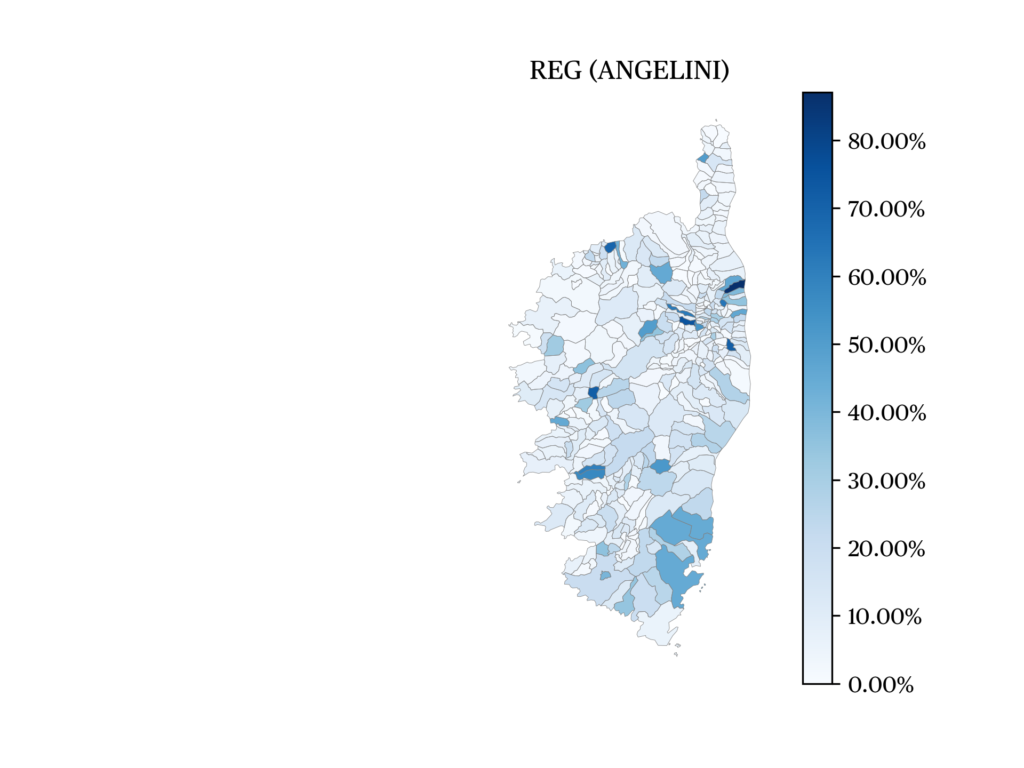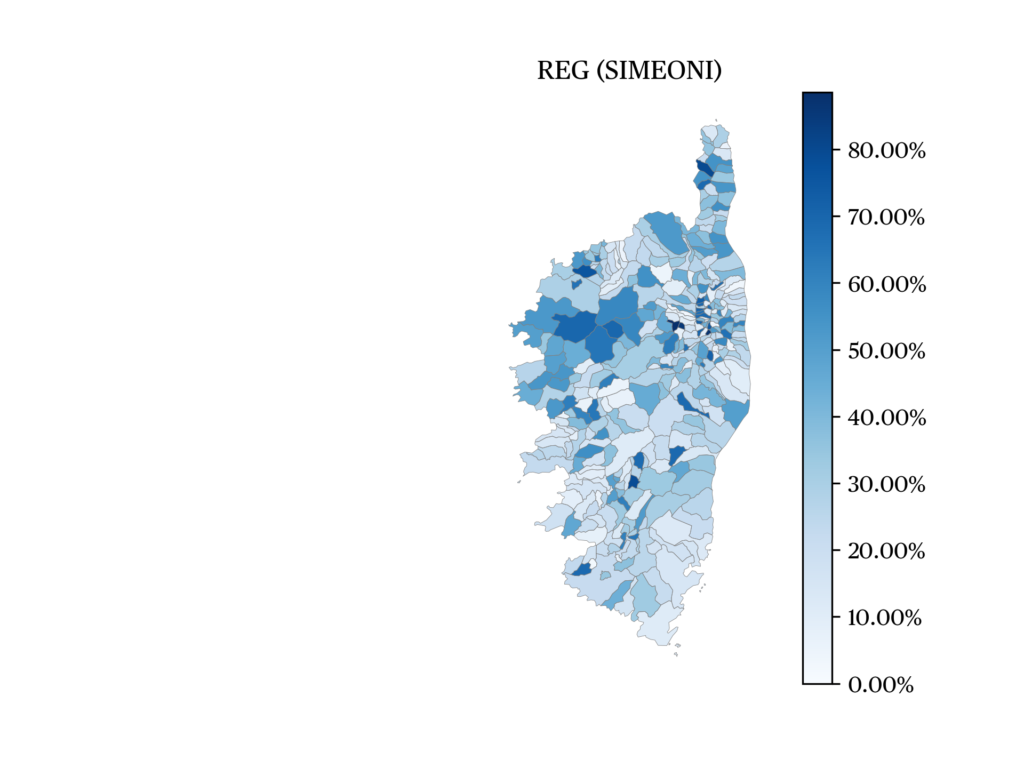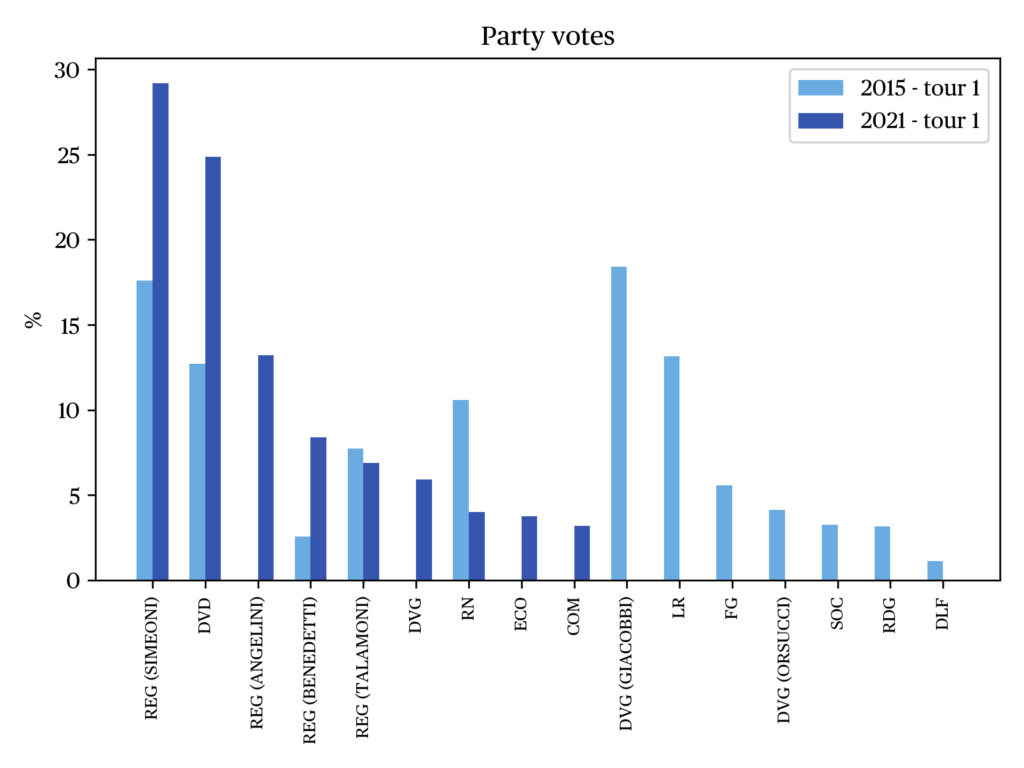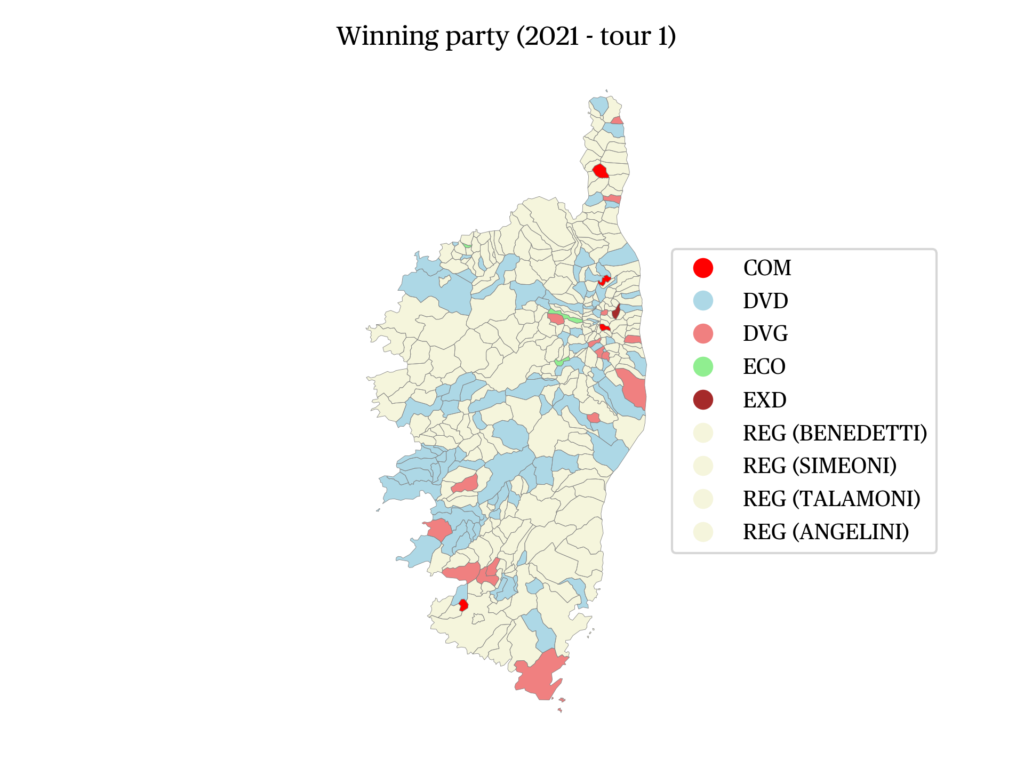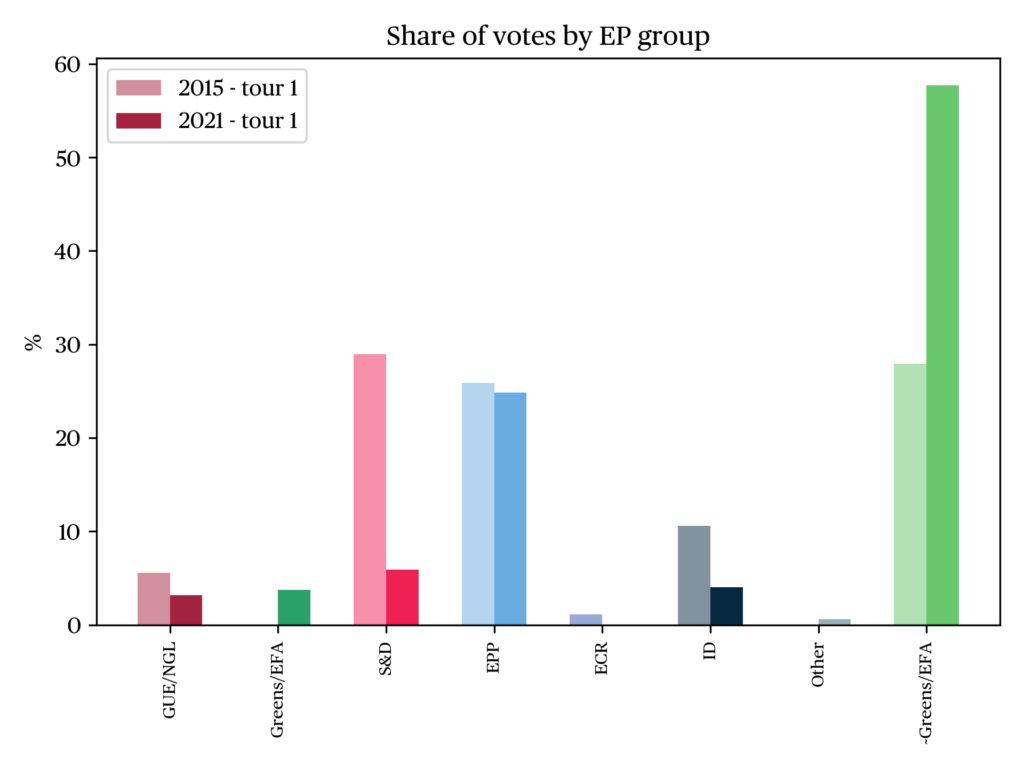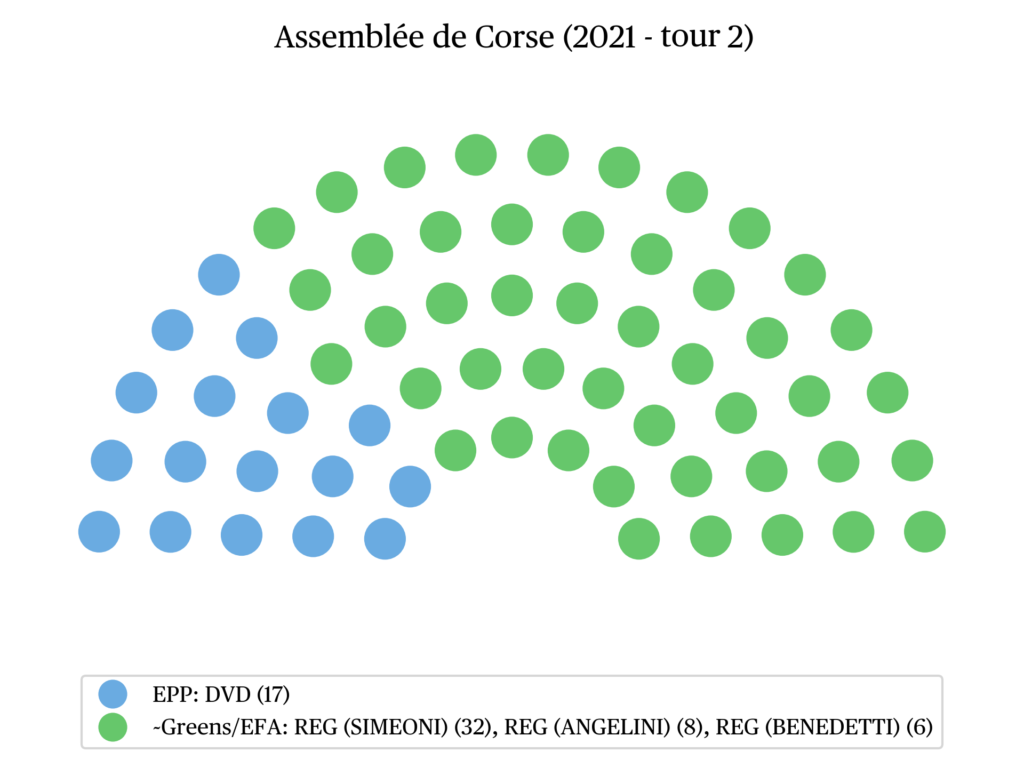Territorial elections in Corsica, 20-27 June 2021
André Fazi
Lecturer in political science at Università di CorsicaIssue
Issue #2Auteurs
André Fazi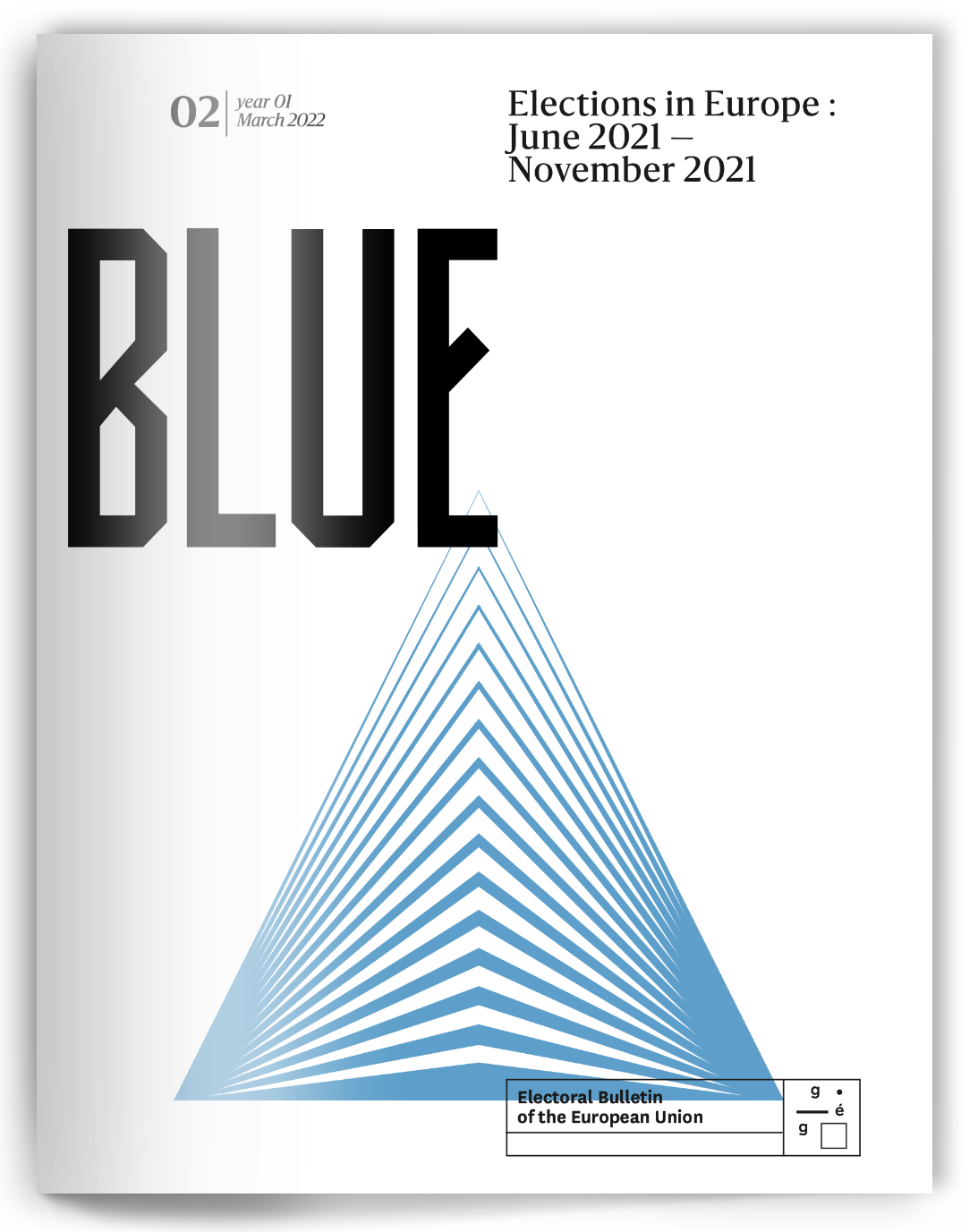
21x29,7cm - 167 pages Issue 2, March 2021 24,00€
Elections in Europe : June 2021 – November 2021
Gathering 67.98% of the votes in the second round of the 2021 territorial elections, Corsican nationalism reached a level of support unique in Europe for such a movement. Among the non-nationalist or unionist lists, only the moderate right-wing list made it to the second round, while remaining far from its ambitions of victory. It is thus a new level that was reached in the nationalist progression and in the territorialisation of the Corsican political system.
In 1982, the creation of a region with a special status initiated a process of legal and political differentiation on the island. This process has accelerated since 2015, with the accession to regional power of the nationalists, i.e. a political movement that fundamentally questions the place of Corsica within the French Republic, and part of which has long used or supported clandestine violence.
Moreover, this electoral progression did not have the expected effects since the French government rejected all the nationalist demands, which generally implied a constitutional revision2. This resistance encouraged the development of tensions between nationalists. Moreover, the nationalist majority was accused of reproducing the atavisms of its predecessors — such as clientelism — which it vehemently denounced, and of being incapable of dealing effectively with concrete issues such as waste management. In short, these were very important elections on at least four levels: the assessment of the nationalist majority’s action, the internal relations within the nationalist movement, the capacity of the unionist players to bounce back, and the future of relations between the institutions of Corsica and those of the Republic. I will deal with this by successively addressing the renewal of the political offer, the victory of Gilles Simeoni and his party, and the new political landscape resulting from this election.
A renewed political offer
Since 1982, the establishment of an Assembly of Corsica elected by proportional representation has led to an incessant movement of political fragmentation and recomposition, which has affected all camps. The territorial elections saw up to 19 lists competing in 2004. However, in 2017, when Corsican voters were to elect for the first time an assembly with considerably enlarged powers, the product of the merger between the regional authority and the two departmental councils, the political spectrum was poorer than ever. The absence of the non-communist left was particularly relevant, especially as the left-wing radicals had dominated politics in the north of the island since the second post-war period.
With ten lists present, the 2021 elections are on the average observed since 1982, but there is a new (dis)balance. Among the national parties, only the French Communist Party was running; the Socialists and Radicals were absent again. This certainly pushed President Macron’s first supporter on the island, Jean-Charles Orsucci, a former member of the Socialist Party, to position himself on the left, excluding any claim to belong to the presidential party. Still, on the left, this election also saw the comeback — for the first time since 1998 — of an ecologist list. It was led by Agnès Simonpietri, who was in charge of the environment in the first nationalist executive council (2015-2017).
On the opposite side of the spectrum, the Rassemblement National [RN] has found a new leader but also a new competitor. The Corsica Fiera [Proud Corsica] list was led by a former RN member, and combined the classic themes of the radical right – opposition to immigration, the European Union and liberal globalisation – with a project of broad autonomy for Corsica, described as ‘shared sovereignty.’
However, the major points were elsewhere. On the moderate right, where, for the first time since 1982, only one list ran in the first round, behind the mayor and president of the Ajaccio agglomeration community, Laurent Marcangeli. Among the nationalists, where the party of the outgoing president of the executive council, Gilles Simeoni, which has become Femu a Corsica [We make Corsica — FaC], chose to form a list without the two partners with whom it had shared power since 2015. The party’s secretary-general said that internal tensions and criticism within the coalition had been a key factor in the decision. The conditions officially set for a new alliance were broad enough to rule out any concrete possibility.
Unlike the 2020 municipal elections, the two minority partners preferred to run separately. The Partitu di a Nazione Corsa [Party of the Corsican Nation — PNC] adopted a strategy similar to that of FaC: to show its convening capacity by integrating some known personalities, coming from the left as well as from the right. Conversely, Corsica Libera [Free Corsica — CL] preferred to reaffirm its pro-independence message. It was all the more predictable that Core in Fronte [Heart forward — CiF], a pro-independence party very critical of the policies carried out by the outgoing majority, seemed able to reach the second round for the first time.
Of course, since 1982, the nationalist division is not the exception but the rule. However, the controversial break-up of the 2015 and 2017 winning alliance was an event that increased the uncertainty of the outcome of the ballot box.

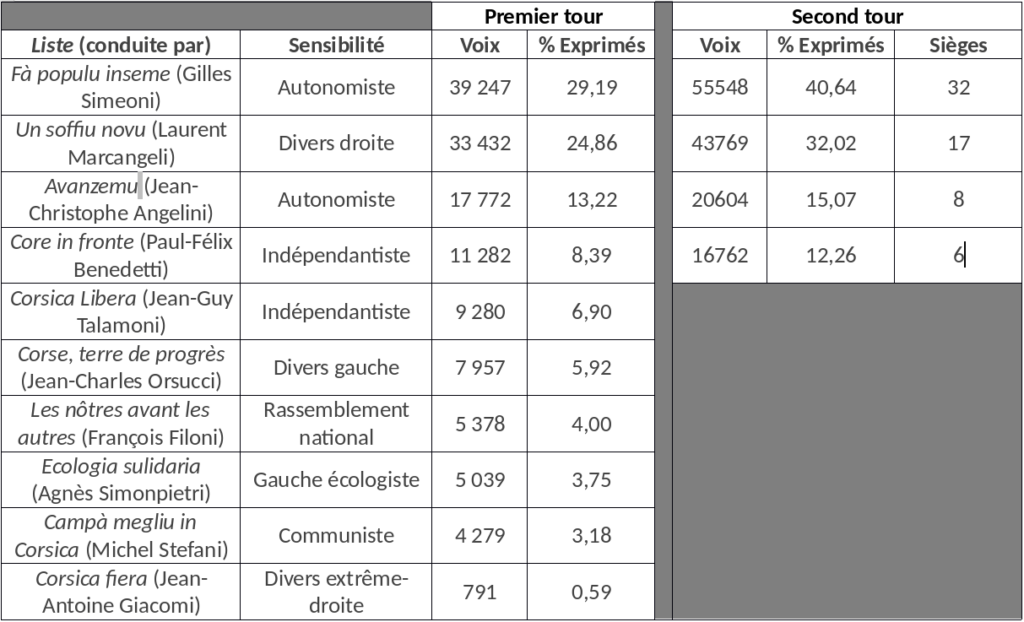
Gilles Simeoni’s successful gamble
While in 2017 the turnout had collapsed — 52.10 and 52.55% in the first and second rounds — the competition between nationalists and the presence of a more representative challenger on the right suggested a revival in 2021. This was the case, with 57.08 and 58.91% of participation, whereas in France as a whole only 33.28 and 34.69% of citizens turned out. That being said, mobilisation for the territorial elections has declined sharply since 2010, when there was still a 69% turnout in the second round.
In terms of the balance of power, with almost 68% of the vote in the second round of 2021, the nationalists have apparently increased their dominance. Nevertheless, this new triumph presents a very diverse configuration. In 2015, it was thanks to a coalition formed for the second round that they won for the first time, and it was only a relative majority of 24 councillors out of 51. The Per a Corsica [for Corsica] coalition united the then autonomist alliance Femu a Corsica — composed of Inseme per a Corsica [together for Corsica] and the PNC — and the pro-independence party CL. Another pro-independence party — Rinnovu Naziunale [National Renewal] — failed to reach the second round.
In 2017, Rinnovu Naziunale, now CiF, has risen and failed near the threshold of accession to the second round (7%), but above all, the Per a Corsica coalition was renewed in the first round and crushed the competition with more than 56% of the votes in the second round. Never since 1982 had a list achieved such results. However, tensions between the partners grew throughout the mandate, marked by the government’s rejection of all nationalist demands. They were concretised during the municipal elections of 2020, where the nationalist offer showed a confounding heterogeneity, and then for the territorial elections of 2021.
However, this division did not cause a global weakening of nationalism. Faced with it, only the right-wing opposition managed to maintain itself within the Corsican Assembly. The left, or at least the unionist left, disappeared. The ecologists were unable to achieve their hopes. Finally, the radical right is very far from what it represented during the 2017 presidential elections, when Marine Le Pen had gathered 48.52% of the votes in the second round.
Many observers note the concomitance between the rise of the RN vote in the presidential elections and that of the nationalist vote in the regional elections. But if there is no doubt that Corsican voters vote nationalist in the territorial elections and RN in the presidential elections, there is not enough evidence to suggest a widespread phenomenon. During the previous elections, the town level analysisshowed the no correlation between the two votes. More strikingly, the Le Pen vote in the second round of the 2017 presidential elections had a significant negative effect on the level of the Simeoni vote in the second round of the 2021 territorial elections, while there was no clear correlation with the vote for the other nationalist lists.
On the other hand, since 2017, Gilles Simeoni had rallied a part of the former electorate of the non-communist left, affected by the judicial fall of its leader, the former president Paul Giacobbi. In 2021,
1
he also achieved excellent results in several communes traditionally very much on the right, sometimes with the official support of the mayors. In general, it performs significantly better in the small communes, with less than 300 registered voters, which were previously the most loyal to the unionist parties. The fact that he now holds power probably explains some of the political moves among these communes, which are particularly dependent on regional aid and subsidies.
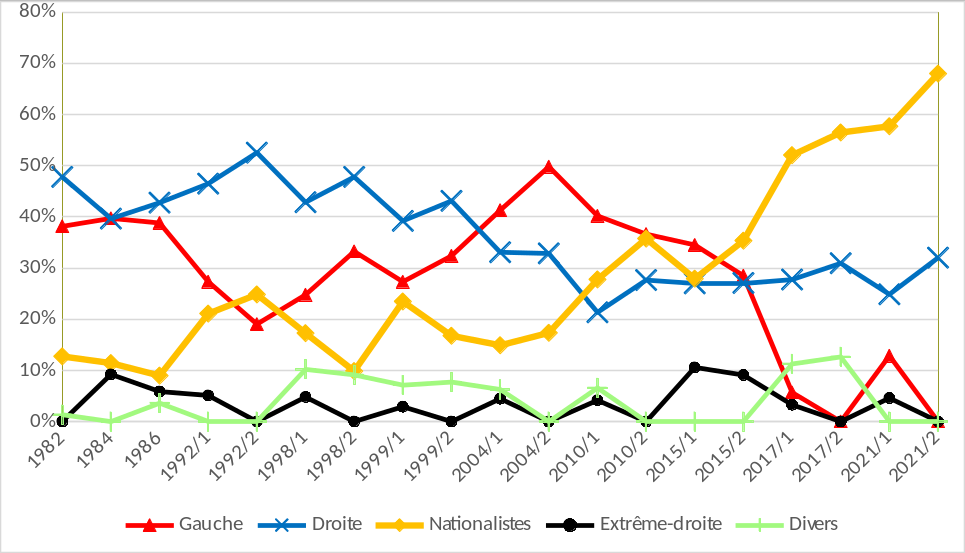
However, Gilles Simeoni has above all managed, despite the challenge of power, to preserve his excellent image, with 71% of positive opinions according to the only poll carried out before the election. In a system where interpersonal relations and local interests still have a powerful impact on electoral choices, his results show a special regularity. Gilles Simeoni succeeded in seducing elected representatives and voters from different leanings, without breaking with his nationalist base. He is the one who benefits from the electoral heritage of the Per a Corsica coalition. Conversely, there is no correlation between the vote for the other autonomist list, the PNC, and the results of 2015 and 2017.
The other big winner is CiF, which has managed to embody a nationalist alternative to the outgoing majority, with a much more radical discourse from both a social and environmental point of view, and a repertoire of protest action that is popular among supporters. On the contrary, on the right, the union from the first round did not convince all the actors. The president of the Les Républicains federation of Haute-Corse, absent from the list, did not hide his criticism. In the end, the list led by Laurent Marcangeli, unanimously considered as the best candidate of his political family, performed less well than the sum of the two lists present in 2017 in the first round, and barely better in the second.
Among the other losers, we find Gilles Simeoni’s former partners. The CL list, led by the outgoing president of the Corsican Assembly, Jean-Guy Talamoni, failed to reach the threshold of accession to the second round by a handful of votes, and the integration of only four CL candidates – without Jean-Guy Talamoni – on the PNC list was far from bearing the expected fruit. The PNC list gained less than 3000 votes between the two rounds, whereas it could theoretically have hoped for more than 9000. Finally, if the failures of the ecologists, the communists and the radical right were not surprising, the collapse of Jean-Charles Orsucci — whose list exceeded 11% in the first round of 2017 — is more relevant and probably confirms that President Macron is not very popular in Corsica, the region where he had achieved his worst result in 2017.
New phase, new uncertainties
If there was little doubt that Gilles Simeoni would be in the lead of the nationalists, the essential question was that of his alliance strategy. Faced with an opposition considered more serious, an alliance with other nationalists, before or after the second round, could not be ruled out. However, thanks to its lead and its campaign dynamics, Gilles Simeoni’s list presented itself alone in the second round. It won the absolute majority in seats by a very small margin (less than 300 votes), and unsurprisingly chose to run the Corsican collectivity alone.
Thus, the first major lesson of these territorial elections is the strengthening of the personification of the Corsican political system. On the one hand, the break-up of the coalition of 2015-2021 was interpreted, probably too simplistically, as the product of individual discord. On the other hand, the strong variations recorded in the different communes suggest that personal attachments played a more important role in the results of the nationalist parties, particularly for the PNC.
Finally, Gilles Simeoni’s personal stature is further enhanced. The communal data show that since the first victory in 2015, his personality has been decisive in the nationalist progression, seducing voters from all horizons.
The second major lesson is therefore the increased normalisation, or mainstreamisation, of the Corsican nationalist vote and especially the Simeoni vote. In the 1980s, the nationalist vote was an anti-system vote. In 2021, the Simeoni vote is the balanced choice, between independentist inclinations which are often considered unviable and unionist parties whose influence and attractiveness are constantly decreasing, especially on the left. This raises the question of pluralism in the Corsican Assembly. Of course, the Corsican nationalists do not all have the same economic, social and environmental sensibilities conceptions. However, the absence of several important political families is a priori detrimental to the debate.
In terms of perspectives, the recomposition of the nationalist field, combined with the threat by clandestine organisations of a resurgence of violent actions, opens a new phase. Gilles Simeoni, who now needs no one to pass his deliberations and his budget, will have to demonstrate more clearly the quality of his policies. However, he will also have to address the other nationalists if he wants to be able to deal effectively with the state. Without a broad regional consensus, it is unlikely that the central government will revise the constitution and respond favourably — at least in part — to nationalist demands. The task will certainly be complicated.
References
Alta Frequenza (2021, 25 April). Territoriales : Femu a Corsica veut dépasser le contrat Pè a Corsica et propose un nouveau contrat à ceux qui souhaitent le rejoindre. Alta Frequenza. Online.
Corse-Matin (2021, 12 May). Interview de François-Xavier Ceccoli. Corse-Matin.
Crettiez, X. (1999). La question corse. Bruxelles: Complexe.
Fazi, A. (2020). La résistance de l’État unitaire, ou un nouveau défi pour le nationalisme corse. In Levrat, N. et al. (dir.), L’Union européenne et les nationalismes régionaux. Genève: Publications du Centre de compétences Dusan Sidjanski en études européennes, pp. 107-126.
Fazi, A. (2017). Les élections présidentielles et législatives de 2017 : une nouvelle phase de dénationalisation du politique en Corse ?. Pôle Sud, n° 47, pp. 163-178.
Fazi, A. (2021). Le nationalisme corse et les élections municipales : une conquête équivoque. Pôle Sud, n° 54, pp. 51-68.
France 3 (2021, 2 September). Corse : le FLNC durcit le ton, et menace de reprendre les armes. France 3 Corse Via Stella. Online.
Teinturier, B. et al. (2021). Sondage d’intentions de vote pour les élections territoriales en Corse. Ipsos/Sopra Steria pour France 3. Online.
Notes
citer l'article
André Fazi, Territorial elections in Corsica, 20-27 June 2021, Mar 2022, 68-72.
à lire dans cette issue
voir toute la revue






